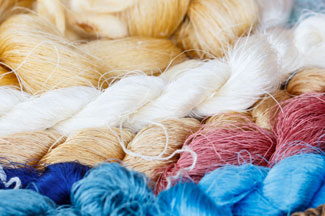How Carpet is Made
KNOWING HOW CARPET IS MADE CAN BE VERY ADVANTAGEOUS.
This knowledge enables you to understand the product’s materials from birth. Knowing the different materials that make up carpet also helps you understand and evaluate their performance aspects such as why certain carpets are easier to install, why some wear better and longer, and why others are easier to care for and clean. Understanding carpet manufacturing and materials can make you a more informed shopper, help you determine the value, and keep you inside the borders of your home improvement budget.
TO UNDERSTAND CARPET IS TO KNOW ABOUT FIBER.
Fiber is the basic material of which carpet is made. Over ninety percent of all the carpet made today is made from synthetic fiber. The rest is natural fiber, most commonly wool. Synthetic fibers are made of one of three materials: nylon, polypropylene, or polyester. All three are created by similar chemical processes using oil and natural gas.
NYLON LEADS THE WAY.
Almost 75% of carpet today is made of nylon and compared to the other fibers, it performs best overall. Nylon is the leader in appearance retention, fade and heat resistance, soil and stain resistance, and color and styling.
POLYPROPYLENE IS GAINING POPULARITY.
The next most common material used in carpet fibers is polypropylene. It has seen fast growth and represents more than 35% of the total fibers used in the carpet industry. While polypropylene is not as resilient or resistant to abrasion as nylon, it is naturally stain, fade, and moisture resistant. Polypropylene is most often used in loop pile carpet constructions.
POLYESTER’S PERFORMANCE SATISFIES MANY.
The third type of material used in carpet manufacturing is polyester. It is well accepted for its bulkiness, color clarity, and stain and fade resistance. Today’s new technologies allow polyester to be a good performer.
WOOL IS NATURAL AND EXPENSIVE.
The other type of fiber used in carpet construction is staple fiber, made from wool, and is a natural product. The wool used in today’s carpet comes primarily from New Zealand, Argentina, and the United Kingdom. Since wool is a natural fiber, it ranges in color from off-white to black, with many earthen tones in between. Although wool doesn’t stand up to abrasion and moisture as well as synthetics, it cleans well and is known to age gracefully. Wool is the most expensive carpet fiber and represents less than one percent of the U.S. carpet market.
CARPET IS MADE IN A THREE-PART PROCESS.
TUFTING: The first step to making carpet begins with tufting. This is a process of weaving the fibers into a primary backing material made of woven polypropylene. Its main value is to provide a base cloth to hold the yarn in place while the tufting happens. Tufting is done with a tufting machine that has up to 2,000 needles working together to pull the yarn through the primary backing material. As the needles penetrate the backing, a small hook, called a looper, grabs the yarn and holds it in place. This process results in what is called loop pile construction. Loop pile products hold their appearance exceptionally well because there are no exposed yarn tips.
In some carpet styles, the looper then rocks back against a knife, where the loops of yarn are cut, creating what we call a cut pile carpet. The length of these cut pieces of yarn is referred to as the pile height. The precision cuts are controlled by a computer and can be programmed to cut only some of the loops. This method of selectively cutting, called cut and loop construction, creates a recognizable pattern on the surface of the carpet.
APPLICATION OF DYE: The second step of carpet manufacturing is the application of dye. Carpet can be taken through one of two dyeing processes. The first method of dyeing is called yarn dyeing or pre-dyeing. This is when color is applied to the yarn prior to tufting. The second method involves applying color to the yarn after the carpet has been tufted. This method is called carpet dyeing. Carpet dyeing can be done through three different techniques.
The first technique, often referred to as Beck or batch dyeing, involves stitching the end of the carpet together and then running the tufted carpet loop through large vats of dye and water for several hours. This process is ideal for smaller production runs and heavier face weight products.
Continuous dyeing is a similar process but involves running the carpet through several processes in addition to just the dye application. Continuous dyeing applies the color directly to the carpet face by spraying or printing. This process can be used to create multicolor or patterned effects.
Screen printing is another common method of carpet coloring and color is applied through silk screens. The major benefit of carpet dyeing after the tufting process is greater color flexibility and a lower cost.
FINISHING: The third and last step in the manufacturing process is the finishing process. This is typically a single production line that completes the final stage of the carpet construction. In the finishing process, a coating of latex is applied to both the tufted, dyed carpet’s primary backing, and is also added to a secondary backing. The secondary backing is typically made of a woven synthetic polypropylene material. The two parts are squeezed together in a large heated press, where they are held firmly to preserve their shape. Shearing happens during this time and all the loose ends and projecting fibers are removed. This also helps achieve the yarn’s tip definition. Finally, each carpet is carefully inspected for color uniformity and other manufacturing defects before it is rolled, wrapped, and shipped.






